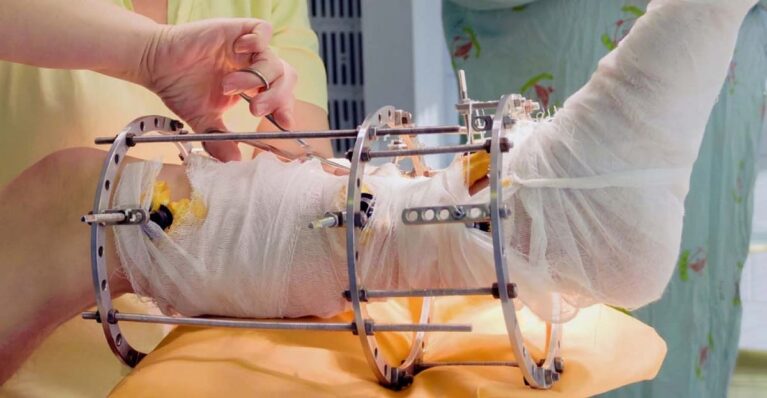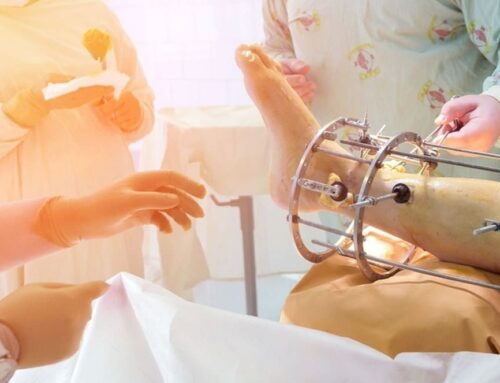External fixators are crucial devices in orthopedic surgery used to stabilize bone fractures, facilitate healing, and maintain proper alignment of bone segments. Here are the main types of external fixators used in orthopedics:
Unilateral (Monolateral) Fixators
- Description: These fixators consist of a single bar or rod that is attached to the bone using pins or screws on one side of the limb.
- Applications: Often used for simpler fractures and in pediatric cases.
- Advantages: Easier to apply and adjust; less bulky compared to other types.
Circular (Ring) Fixators
- Description: Composed of rings or semicircles connected by rods, wires, and pins that encircle the limb. The most well-known example is the Ilizarov apparatus.
- Applications: Ideal for complex fractures, limb lengthening, deformity correction, and fractures with bone loss.
- Advantages: Provides versatile and stable fixation; allows for gradual adjustments and corrections.
Hybrid Fixators
- Description: Combine elements of unilateral and circular fixators, typically using a ring proximally and a unilateral frame distally.
- Applications: Used for fractures that require the benefits of both unilateral and circular fixators, such as periarticular fractures.
- Advantages: Offers the stability and versatility of circular fixators with the simplicity of unilateral fixators.
Modular Fixators
- Description: Composed of individual components that can be assembled in various configurations to suit the specific fracture needs.
- Applications: Versatile use for different types and locations of fractures.
- Advantages: Highly customizable; can be adjusted during the healing process.
Hinged Fixators
- Description: Include hinges that allow for controlled movement at the fracture or joint site.
- Applications: Used in cases where controlled motion is necessary for proper healing, such as in joint fractures or elbow injuries.
- Advantages: Allows for early mobilization of the joint while maintaining fracture stability.
Pelvic Fixators
- Description: Specifically designed for the stabilization of pelvic fractures. They typically involve pins inserted into the iliac crests connected by rods or frames.
- Applications: Used in cases of severe pelvic fractures or disruptions.
- Advantages: Provides stable fixation for the pelvis, which is critical for patient mobility and function.
Spanning (Bridging) Fixators
- Description: These fixators span across a joint, maintaining alignment and stability while allowing the joint to remain immobilized.
- Applications: Commonly used for complex periarticular fractures (e.g., distal radius, distal tibia) and in cases of severe soft tissue injury.
- Advantages: Helps in maintaining limb length and alignment while protecting the joint from further injury.
Bone Transport Fixators
- Description: A specialized type of circular fixator used for segmental bone transport, typically involving the Ilizarov technique.
- Applications: Used for treating bone defects, non-unions, and length discrepancies.
- Advantages: Allows for gradual bone lengthening and reconstruction.
Key Considerations in External Fixator Use
- Stability: Ensuring the fixator provides adequate stability for the specific fracture type.
- Adjustability: Ability to adjust the fixator as healing progresses or to correct alignment.
- Patient Comfort: Minimizing discomfort and inconvenience for the patient during the healing process.
- Infection Control: Regular monitoring and care of pin sites to prevent infection.
External fixators play a vital role in managing complex fractures and orthopedic conditions, offering versatility and the ability to tailor treatment to the individual needs of the patient.
Difference Between Internal and External Fixators
Internal and external fixators are two primary methods used in orthopedic surgery to stabilize and facilitate the healing of bone fractures. Here are the key differences between them:
Internal Fixators
Definition:
Internal fixators are devices implanted inside the body to stabilize broken bones.
Types:
- Locking Plates and Screws: Metal plates attached to the bone with screws.
- Intramedullary Nails/Rods: Rods inserted into the marrow canal of long bones.
- Pins and Wires: Thin metal pins or wires used to hold small bone fragments together.
Applications:
- Fracture Fixation: Commonly used for long bone fractures, joint fractures, and complex fractures.
- Spinal Surgery: Used to stabilize vertebrae in spinal fusion procedures.
- Reconstructive Surgery: Utilized in bone deformity corrections and joint replacements.
Advantages:
- Stability: Provides rigid fixation and stability.
- Cosmetic: No external hardware visible, which can improve cosmetic outcomes.
- Mobility: Often allows for earlier mobilization of the affected limb.
Disadvantages:
- Invasive: Requires a surgical procedure to implant and often to remove the device.
- Infection Risk: Risk of deep infections, which can be more challenging to treat.
- Healing Complications: Potential for complications such as hardware failure or non-union of the bone.
External Fixators
Definition:
External fixators are devices applied outside the body, connected to the bone via pins or wires that penetrate the skin.
Types:
- Unilateral (Monolateral) Fixators: Single-sided frame.
- Circular (Ring) Fixators: Ring structures, such as the Ilizarov apparatus.
- Hybrid Fixators: Combination of unilateral and circular elements.
- Pelvic Fixators: Specifically designed for pelvic fractures.
- Spanning Fixators: Spans a joint to immobilize it.
Applications:
- Complex Fractures: Used for severe, open, or comminuted fractures.
- Soft Tissue Injuries: Ideal for fractures with significant soft tissue damage.
- Limb Lengthening: Used in procedures for bone lengthening or deformity correction.
- Pediatric Cases: Sometimes preferred in children to avoid growth plate damage.
Advantages:
- Adjustability: Allows for adjustments during the healing process.
- Minimally Invasive: Can be applied with less invasive procedures, reducing initial trauma.
- Versatility: Useful for managing complex fractures and soft tissue conditions.
Disadvantages:
- Infection Risk: High risk of pin site infections, which require careful monitoring.
- Discomfort: Can be uncomfortable and cumbersome for the patient.
- Cosmetic Impact: Visible external hardware can be unappealing and stigmatizing.
Key Differences
Placement:
- Internal Fixators: Implanted inside the body, directly attached to the bone.
- External Fixators: Placed outside the body, connected to the bone via percutaneous pins or wires.
Surgical Procedure:
- Internal Fixators: Require more invasive surgical procedures for implantation and removal.
- External Fixators: Less invasive to apply, but removal also involves a minor procedure.
Visibility and Comfort:
- Internal Fixators: Not visible after the surgery, generally more comfortable once implanted.
- External Fixators: Visible external components, which can be bulky and uncomfortable.
Adjustability:
- Internal Fixators: Typically fixed in place once implanted, limited adjustability post-surgery.
- External Fixators: Highly adjustable, allowing for modifications during the healing process.
Infection Risk:
- Internal Fixators: Risk of deep infections, which can be more serious but less frequent.
- External Fixators: Higher risk of superficial pin site infections, requiring diligent care.
Both internal and external fixators have their specific uses, benefits, and drawbacks, and the choice between them depends on the nature of the fracture, the patient’s condition, and the goals of the treatment.




Leave A Comment